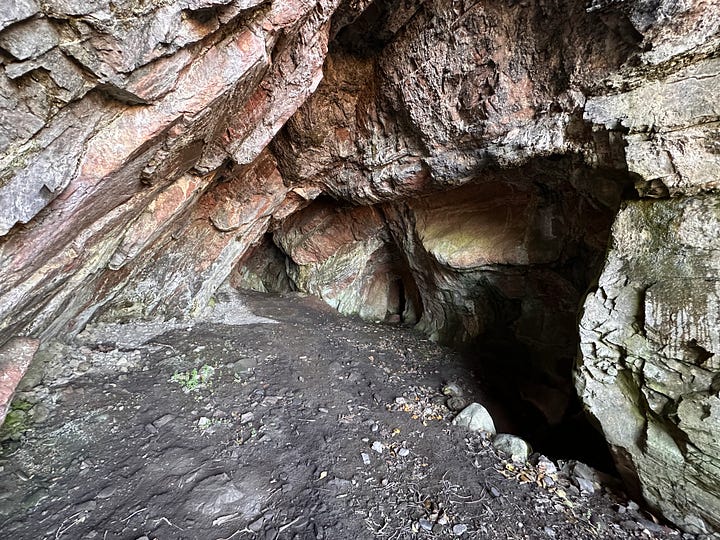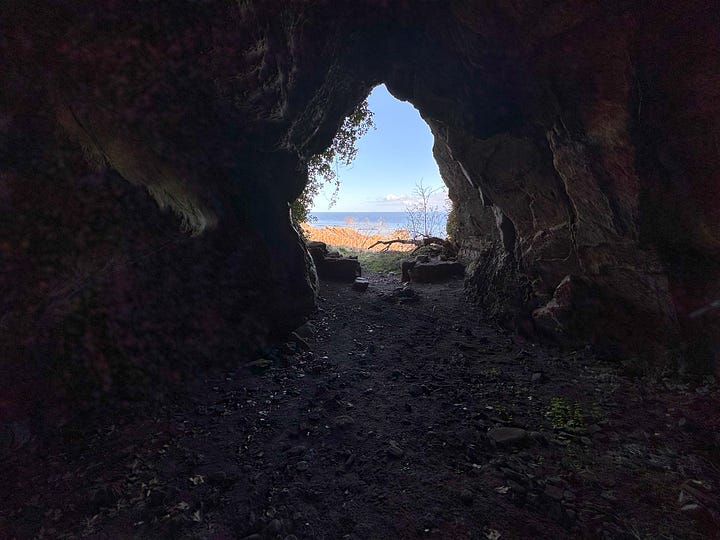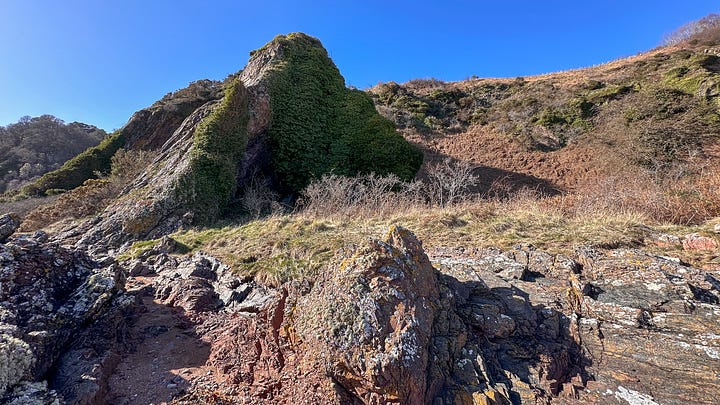Hello Everyone,
This post is quite a long one so grab yourself a cuppa and come along for the ride. I will also admit that I started this back in March hence the reference to the Spring equinox…better late than never!
Note: This post contains a lot of pictures which means it will appear as clipped or truncated in an email. To see the whole thing just press VIEW ENTIRE MESSAGE at the end of the email and you’ll see it in one. Or head to the online version.
Way back in December, Alexander M Crow issued an open invitation to collaborate in Season 2 of his Ancestral, Wild Empowerment series which looks at
“how we can use hunter-fisher-gatherer ancestral skills and knowledge, in order to bring a deep sense of empowerment and calm in today's modern, busy world and, through these skills and this knowledge, help return a balance to nature.”
This is an interesting concept as we wouldn’t be where we are now without the skills acquired by our prehistoric ancestors. I often wonder what the original thought processes were that led to learning how to use the natural materials around them for tools, clothing, containers, ever more sophisticated shelters. And metal; just how was that first step taken?
I responded to Alexander’s invitation that I was interested in being part of his project and then almost immediately forgot about it. There was a lot going on towards the end of last year and the start of this!
The Spring Equinox arrived and with it Alexander’s letter that the first topic he would be looking at was shelter. Coincidentally, I had already thought that I would write about some caves nearby. Given the happenstance, and the glorious weather we were gifted on 20th March, I set off to visit a couple of the caves - they turned out to be much further along the headland than I remembered!
As with many things that I do, I started out with one idea and then distracted myself. I thought that I would try view the landscape, and its resources, from the perspective of a prehistoric person (sort of in line with Alexander’s brief), and to an extent I did that, but then I started to wonder about how the caves were used and wandered off piste as there is such a good story to tell about one of the caves I visited. It also opens up the fact that, although we have a very good idea how our prehistoric ancestors lived on a practical level, we do not fully understand their worldview, and nor may we ever. We can hypothesise but will never know how their cosmology evolved.
I live in the Black Isle, which, despite its name, is not an island but a peninsula. It’s an area of rich farmland to the northeast of Inverness in the Highlands of Scotland. Due to the centuries of farming that have taken place here, there are few immediately obvious physical remnants of our prehistoric ancestors bar the scant remains of chambered tombs that housed their dead and proclaimed their ownership of the land. Powerful visual statements of the intra- and interconnectedness of the people who inhabited the landscape.

Along the south-east coast of the Black Isle, on the northern shore of the Inner Moray Firth, running from Rosemarkie to Cromarty are 19 caves. The caves sit 3 m to 10 m above the present high water mark and most would have been large enough to be occupied permanently or intermittently. Since 2006, the archaeology of these caves has been surveyed and investigated, the results of which indicate that a number of the caves have been visited or occupied in prehistory.
Once you get beyond the sandy bay that fronts Rosemarkie, the shore forms a space between the waters of the Moray Firth and the sheer cliffs that mark a harsh transition to the land beyond. A shore that alters in size as the tide washes in and out; a shore that a cursory glance suggests is lacking in resources. However, small rock pools are exposed with the receding water as are rocky outcrops and boulders and stones of varying sizes. It slowly becomes clear that there are shellfish (I spotted limpet, periwinkle, whelk, mussel, oyster and razor clam shells as I walked) and crabs to be gathered, and various types of seaweed to be harvested. Frequent visits by a local dolphin population attest to the availability of salmon in the bay, seals come and go, and cormorants use the shoreline rocks to stand and dry their wings. Steep as they are, the cliff faces are covered in trees. These days, there is the occasional Scots pine and birch tree. Bracken abounds, and there is gorse, broom, ivy, marram grass and bramble to add to the store cupboard. Fresh water streams cascade from land to sea at regular intervals.


Caird’s Cave
Caird’s Cave, the nearest to Rosemarkie, was last occupied by travellers in the early 20th century: Mr ‘Captain’ and Mrs William Devine. The name Caird’s Cave, in fact, derives from ceard, Gaelic for travelling craft workers and gypsies.
Excavations in 2010 established that there had been occupation from the 4th or 3rd centuries BCE to the 2nd or 3rd centuries CE setting the time frame firmly in the Iron Age. There had been later occupation but those deposits had been entirely removed during excavations by antiquarians, Dr William Maclean and Colonel William Hall between 1907 and 1912.
From the artefacts recovered from Caird’s Cave, it would appear that our Iron Age ancestors made good use of the resources at their disposal. A large amount of periwinkle and limpet shells were recovered; shellfish species that required more effort to gather, such as oyster, mussel and scallop, were uncommon. Crab shell was also common.
A small amount of fish bone and animal bone was also present. The fish bones tell us that juvenile gaddis, such as cod, haddock and saithe, were caught from the safety of the shore or rocky outcrops along the shore. However, bones from mature cod and haddock were also identified among the assemblage indicating that the cave inhabitants ventured offshore to catch them. This would have required a vessel of some sort, as well as hooked lines, all of which could have been manufactured from materials sourced on or near to the shore.
The animal bones were highly fragmented which made identification extremely difficult, but there appeared to be sheep-like animals together with a medium-large animal group, which was deemed most likely to be deer as well as cattle.
There was a broad range of simple stone tools, including a fragment of saddle quern, quern stone rubber, a hammer stone, two small burnishing stones and a possible whetstone - all items, of course, that could relate to any time from prehistory to more recent centuries, but the raw materials for such could be gathered from the shore. Burnt and fractured stones tell of hearths and pot boilers.



Learnie 2B and Rosemarkie Man
Further round the headland at Learnie (hence the long walk) is a suite of three caves which have also seen excavation since 2006 (I volunteered on that one). In 2016, it was discovered that these caves had also been used in the Iron Age, although for a much more esoteric use than Caird’s Cave.




At the end of a phase of excavation, the well-preserved skeletal remains of a young Caucasian male were found buried within a dark alcove in the cave’s interior. The position of the burial and the condition of the individual at death is unusual. Aligned northwest-southeast, with the skull to the southeast, the arms were level by the side of the torso, while the lower limbs/feet had been crossed to form a ‘cross-legged’ position with the knees splayed and raised upward. A heavy beach cobble had been placed over the feet and lower limbs, with smaller stones placed over the right hand and left upper leg. A discrete deposit of butchered mammal bone was located over the location of the skull, with scattered deposits of butchered bone found within the sand over the inhumed remains.

As is the norm in Scotland, the local constabulary were informed of the discovery of a skeleton, even though the archaeologists on site were confident of its antiquity. The Procurator Fiscal’s office was then informed, and they in turn contacted Dame Sue Black, a forensic anthropologist, who was then at the Centre for Anatomy and Human Identification in Dundee, for a forensic opinion as they thought the skeleton was too complete and well-preserved to be historic. Although she confirmed it was not a modern murder victim, Sue Black was intrigued and carried out a full analysis of the skeleton.
From the limb bones and teeth, he was found to be healthy, probably in his late twenties/early thirties and of average, robust build with a particularly strong upper body. What was not normal was his skull; this had been severely smashed and fractured by multiple trauma wounds from more that one weapon. I’ll let Sue Black take you through the injuries in the short video below. This man had suffered a terrible death.
The team at Dundee also went one step further and made a facial reconstruction of the man (see video below). It is not often we are able to see the faces of our ancestors. While I was still working in archaeology, we had a poster of this chap on the office wall.
It can’t be determined whether there was one or several assailants. It also can’t be said whether the attack was a result of interpersonal conflict (more likely if it was a single assailant) or whether there was a sacrificial element to the attack. The level of trauma inflicted was far greater than would have been needed to kill him; this has led to a comparison with Iron Age bog bodies where high status individuals, who may have been willing or perhaps compliant, suffered a ‘multiple’ death before being deposited in a watery pool. These deaths are sometimes though to be sacrifices made to propitiate deities during times of poor harvest. Later isotope analysis found that the diet of Rosemarkie Man, as he became known, may have included items such as freshwater fish, water fowl or high level terrestrial fauna like suckling pig suggesting that he was of a higher status than his contemporaries.
The remains of Rosemarkie Man were located on the same archaeological horizon as metal-working deposits and other features. Although not linked, the positioning of post-holes that would have contained a screen suggests the possibility that the burial location was known and respected by the smithing area. The buried man displayed traits of good health and strong stature, in particular his forearms. Could he have been a metal smith and could his burial have marked the start of iron smithing in this cave? The burial act for the man certainly displays traits of a deliberate, ritual act. Human bones have been found in the foundational deposits of Iron Age homes; was this a way to mark new beginnings? Was it thought to bring good luck, appease deities?
As with many discoveries in archaeology, there is a certain amount of conjecture as to the exact reason for Rosemarkie Man’s demise and burial within the cave. However, it isn’t outwith the realms of possibility that he was a sacrifice, whether or not he was willing or compliant in the act. Caves are a liminal space and, as well as being used for the more prosaic domestic or industrial roles, or as storage areas or hideaways, there is evidence for them being used for the deposition of the dead during the prehistoric period. They have also been used for the structured deposition of material culture and rituals involving the preparation and display of human remains. Across the water, and around the headland, is Sculptor’s Cave at Covesea where excavated material suggests two distinct mortuary rites: the laying out of bodies and the curation of (possibly adorned) juvenile heads in the entrance passages in the Late Bronze Age, and the decapitation of individuals inside the cave in the Roman Iron Age, but that is a story for another day.
I liberally dipped into the resources listed below for this post, but they all contain much more information, and many more images and illustrations:
Excavations at Caird’s Cave, Rosemarkie, 2010: Data Structure Report
Introducing Rosemarkie Man: A Pictish Period Cave Burial on the Black Isle











